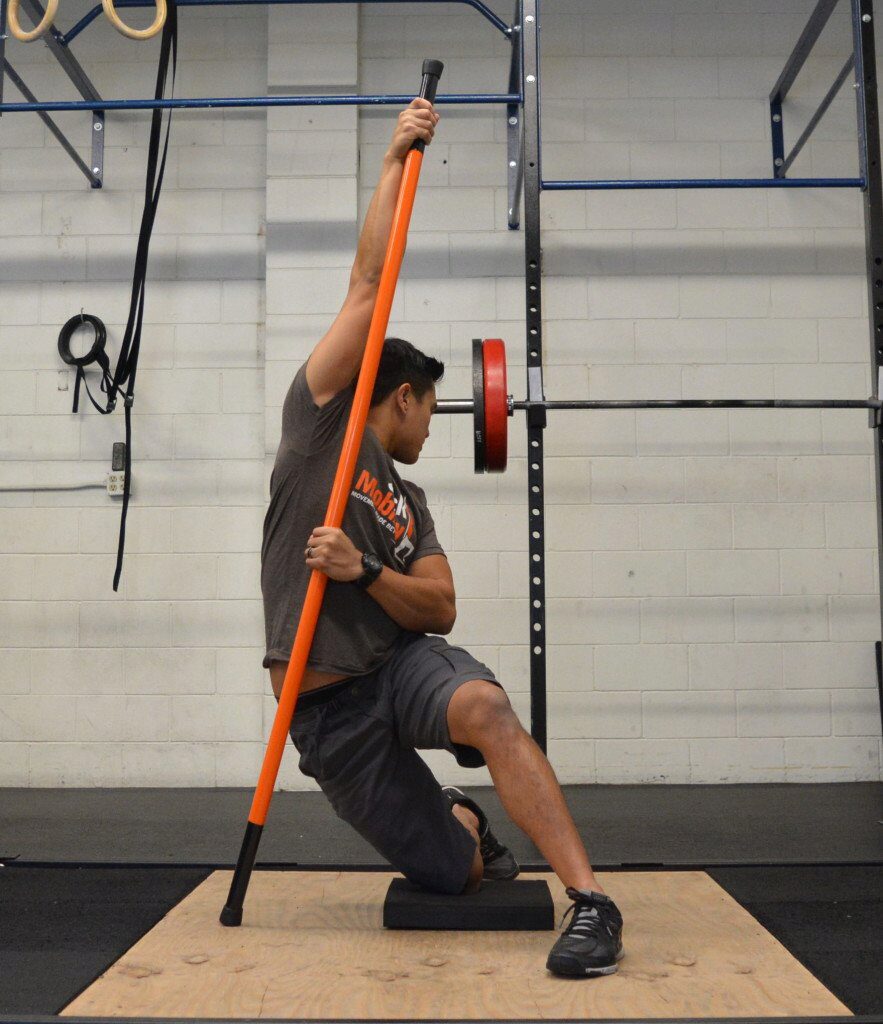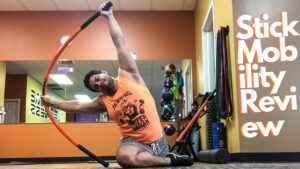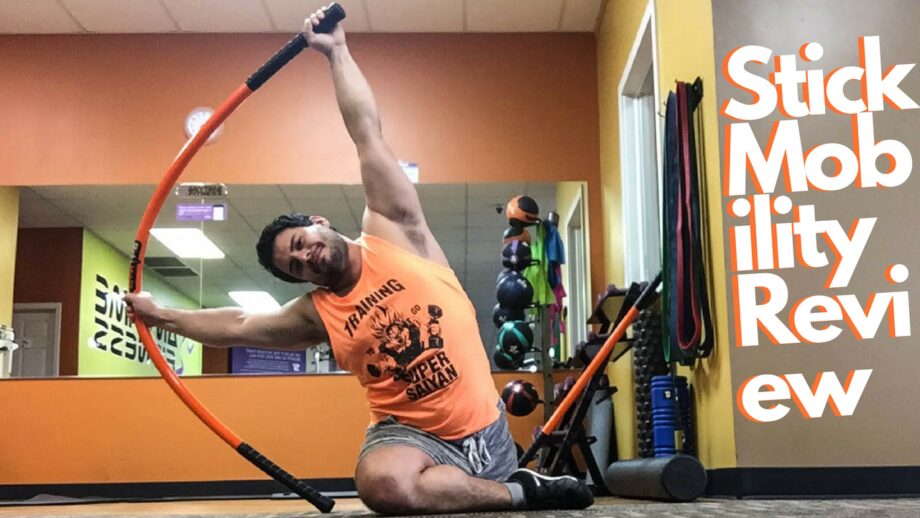We test and review fitness products based on an independent, multi-point methodology. If you use our links to purchase something, we may earn a commission. Read our disclosures.
Stick Mobility offer amazing tools that can allow lifters to add strategic resistance to some traditional “mobility” movements. Made out of specially formulated PVC, these sticks are made to push and pull against as you perform movements and generate muscular tension.
Stick Mobility
Stick Mobility System

Product Highlights
Pros & Cons
Bottom Line
What is Stick Mobility?

Stick Mobility encompasses all of the tools and training of a movement training system founded by a few guys in the state of California in recent years. While it is a movement system itself with certification classes and more, what I will focus on in this review are the sticks themselves.
Dowel rods and PVC pipes can be found in nearly weight room. Historically, these simple tools found their spot in the corners of gyms due to their utility for “warming-up” and for just having something to hold on to while you get loose before activity.
PVC Pipe may not be an expensive purchase, but in the right hands, it can surely enhance the value and quality of any movement you wish to do. As shown in the picture, some gyms highly value their PVC and choose not to throw them in some junk pile.
This brings me to the sticks that Stick Mobility has to offer. At first glance, some may roll their eyes thinking some marketing genius took a highly used and cheap tool, painted it orange, and up-charged the piece to make a profit off of people who would not know better.
Rest assured, this is not the case.
What makes Stick Mobility unique is that they took something a gym rat will potentially use daily and found a way to greatly improve upon it. Typical PVC will deform under pressure and not return to its original shape. Stick Mobility sticks are meant to bend and return – and what this means is a whole new world of body awareness and movement opportunity.
Unboxing
The Stick Mobility sticks came in a large cardboard box. I do not remember the exact details, but I do remember it all came in 1 piece … actually, it came in three pieces since I purchased a bundle set that included one 4’ long stick and two 6’ long sticks. This bundle was recommended to me as the sticks come in a variety of sizes.
I am 5’5” and shaped like Winnie-the-Pooh – if this sort of describes you, then it is recommended that your order the 6-foot and 4-foot sticks. Scratch the Winnie-the-Pooh note – this recommendation is for those who are under 5’10”
If you are above 5’10”, then it is recommended if you are purchasing a bundle to go for the 5 foot and 7 foot long sticks.
Stick Mobility Review

Here at Garage Gym Reviews, we strive to look past training methodologies and choreographies and look at the principle of the matter. Regarding the Stick Mobility Sticks, what I have found is that it has become a valuable tool for me to use multiple times daily.
Grasping one of these sticks in hand, you will find that it is much different from regular PVC pipe.
PVC pipe most popularly comes in either schedule 40 and 80 (different strengths). As noted by their website, Stick Mobility PVC uses a “proprietary blend of extruded materials.”

This specific blend is what makes the stick highly useful compared to regular ole’ PVC. The Stick Mobility formulation allows for a great balance of rigid strength and flexibility. I would compare it to a bow or perhaps a Bowflexrod.
For this review, I will focus on this “bendy” benefit as this is what separates Stick Mobility from normal PVC.

There are two different models of the stick. The standard model is what I have worked with. The pro model is different in that it is thicker and is recommended for people who are very strong or weight over 220 lbs. The different sizes that you are able to purchase are 3, 4, 5, 6, and 7 feet long.
The ends of the stick are covered in grippy tape and what looks like a furniture protector. This is made specifically for your hands.
The sticks themselves do not weight much at all.

What most people use PVC pipe in the gym for is to be a lightweight tool to “warm-up” with. Squats, overhead presses, shoulder circles, etc. While PVC will give and return to an extent, it is not meant to “give” much more than that.
What Stick Mobility opens the user up to is to strategically add tension to movement. Since the stick will not break, you can push and pull it which adds resistance to the muscles that are doing the pushing and pulling. As long as you respect joint mechanics, this can be a very valuable strengthening tool.
Since the sky is the limit when it comes to the different “moves” you can use with the stick, I will only list a few classic examples of what it is I’m talking about.
Squat
The first movement I will highlight is the classic squat. When squatting with normal PVC, basically you place the pipe across your shoulders, squat, and viola. The PVC is pretty much there to mimic a barbell or to make your hands feel like they have a job to do.
Squatting with the Stick Mobility sticks allows for more opportunity for generating muscular tension.
First, hold onto the stick in the vertical position. Place one end of the stick in your hands and the other on a sturdy “ceiling” (e.g., could be an actual ceiling that won’t give, the crossbar of a squat rack, the bottom of a speed bag platform, etc.).

While squatting, what you will do is apply upward tension to the stick via your hands. Focus on expanding your quads and hams and radiating tension throughout your body. Keep applying upward tension through the stick into the “ceiling.” I like to pause at the bottom and focus on the tension generation before I start the ascent back up.
Since co-contraction is occurring around your knee and hip joints, your body is supplying extra tension for you to overcome if your goal is to stand back up with the stick. Some people call this specific method of performing a squat a “Dunphy Squat.” Call it as you wish.
Side-Bend

It can turn a side-bend into a resistance training opportunity by adding a unique direction of resistance to the end range of motion.
The classic side bend aka lateral rotation of the spine. With normal PVC – bend your spine to the range your body allows, squeeze the muscles such as the obliques to get back upright, and repeat. Viola!

Using the Stick Mobility Sticks, one option you have is with the longer stick (such as a 6/7-foot stick) is to increase tension by pushing tension into the middle of the stick.
With the stick in the vertical position, place one end on the ground out to the side of the foot. With the hand opposite to the foot, grab the top end of the stick with your palm facing forward. With your free hand, you will grab the middle of the stick and “push” into the side bend motion (deforming the stick into a bow).
Squeeze those muscles lateral the spine to the side range your body will allow for. A good method to perform here are either isometric tensioning or perhaps tiny oscillating contractions, returning the stick from a bow back to vertical again.
Bows and Arrows

If you ever attend a Stick Mobility® class, perhaps you will learn one of the “bow and arrow” moves. This involves you getting your body into a forward or side lunge position and rotating your torso one way or another. What you will do with the stick is having one hand high and one hand in the middle, you will press into it so that it forms a bow. Pressing into the stick increases muscular tension in the muscles causing the stick to deform. And what’s great when compared to regular ole’ PVC is that the sticks will return to normal shape every time.
In the three movements I listed above, what the Stick Mobility stick provides is resistance that would not normally be available without the stick.
There are other movements you can perform that call for the use of two long sticks, but I have yet to find a place for this in my own training. One of the movements is called the “monkey hang” and its where with one stick in each hand (and the other ends fixed on the ground) you “hang.” It is pretty cool that the sticks are strong enough that you are able to hang on them without you having to worry if they will snap or what not.

Stick Mobility does offer a “pro” model designed for stronger or heavier users, but I have yet to use them to judge the extra resistance they provide. These sticks need to be looked at as resistance tools instead of just mere PVC pipe.
As Tom Purvis (Resistance Training Specialist) can remind us, “Train movers before movement.” What this means is to remember what is actually causing “movement.” Muscle is the foundation of movement, so before you go on learning any new “moves” or finding value within a movement system, make sure your muscles are strong and ready! The sticks are definitely a novel training stimulus for your muscles.
What I see in the value Stick Mobility is the ability to have something for your muscles to squeeze against. Perhaps as a former gym owner, it’s also nice having something that doesn’t necessarily look like cheap PVC but rather sharp and innovative.
Suggested Improvements

Honestly – there isn’t much to improve on a stick that is already so simple in the formulation. So what I will suggest are other tools to go along with it.
In the era of earthquake bars and whatnot, perhaps Stick Mobility could design a barbell or a stick specifically designed to load weight onto. Good or bad idea? – who knows?
It may be nice to build a sturdy carabiner designed to slide onto the stick to add an outside line of resistance to certain movements. How reasonable that would be or absolutely necessary, I’m not sure.
Full Rating
Stick Mobility System

The Stick Mobility Systems offers amazing tools that can allow lifters to add strategic resistance to some traditional mobility movements. Made out of specially formulated PVC, these sticks are made to push and pull against as you perform movements and generate muscular tension.
Product Brand: Stick Mobility
Product Currency: $
Product Price: 39
Product In-Stock: InStock
4.5
Stick Mobility FAQs
Are mobility sticks worth it?
Stick Mobility can help you develop spatial awareness, motor control, and stability while rotating your body, as well as loosen up your shoulders and hips. There’s even a video library dedicated to golf mobility exercises.
Is stick exercise good?
Full-body mobility; abs, feet, and grip are all strengthened. Hold the stick across your back and do it. Bend your knees and hinge at your hips. Rotate one end until it’s firmly planted on the ground.
What is stick mobility made of?
They are completely waterproof and simple to clean. They’re created in the USA from a special combination of synthetic plastic with silicone rubber grips that are engineered to achieve the perfect balance of flexibility and strength for all Stick Mobility activities.
Where to Purchase
Stick Mobility
Stick Mobility System

Product Highlights
Pros & Cons
Bottom Line
Further reading

Curious about this unique piece of equipment from Bowflex? Find out more about it with this Bowflex TreadClimber TC5000 review. Read more

Check out our FreeMotion t8.9b treadmill review to see what we really think about this super-expensive cardio machine. Read more

For this Pride pre-workout review, a sports dietitian reviews the supplement from the same company that makes OxyShred to see if it’s worth the cost. Read more

Curious about casein protein? Our Legion Casein+ review will explain everything you need to know about this micellar casein protein powder. Read more

